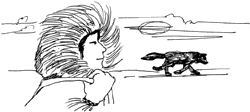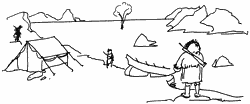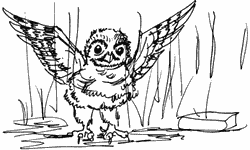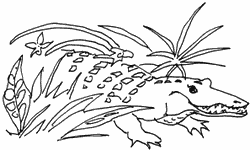My Side of the Mountain has always been one of my favorite books. What inspired you to write it?

Let me tell you why I wrote My Side of the Mountain. When I was a kid, my father, who was an entomologist and ecologist, took my brothers and me into the wilderness along the Potomac River near Washington, D. C., our home. He taught us the plants and animals, where to find wild asparagus and other edible plants. We made lean-tos to sleep in, fished with our own homemade fish hooks and basswood fiber lines and trained falcons. My brothers were two of the first falconers in the United States and gave me a falcon to train when I was thirteen. It was a glorious childhood.
When I became a writer I wanted to tell about those wonderful days. I wrote eight books before I saw a way to get Sam out in the wilderness without the park rangers or his family coming to get him. He would tell his Dad he was going to go to the family farm in the Catskill Mountains. Then I put myself in Sam's head and began to write using my own adventures, including eating all those delicious foods .
I have written the sequel, On The Far Side of the Mountain. When I started it my daughter Twig said, "Put a girl in this book." and I asked, "Who?" Her answer was, "One of Sam's sisters, and make her just like my independent little girl, Caity." And that's what I did after spending a summer in the Catskill and Helderberg Mountains studying the plants, animals and trails.
When I became a writer I wanted to tell about those wonderful days. I wrote eight books before I saw a way to get Sam out in the wilderness without the park rangers or his family coming to get him. He would tell his Dad he was going to go to the family farm in the Catskill Mountains. Then I put myself in Sam's head and began to write using my own adventures, including eating all those delicious foods .
I have written the sequel, On The Far Side of the Mountain. When I started it my daughter Twig said, "Put a girl in this book." and I asked, "Who?" Her answer was, "One of Sam's sisters, and make her just like my independent little girl, Caity." And that's what I did after spending a summer in the Catskill and Helderberg Mountains studying the plants, animals and trails.
How did you get the idea to write Julie of the Wolves?

The idea for the book struck me when I was in Barrow, Alaska, on an assignment for a national magazine. Barrow is the land of the midnight sun, of sea ice and Eskimos, of caribou and polar bears -- and of wolves.
When my son Luke and I arrived the scientists at the Barrow Arctic Research Lab were studying wolves and breaking their communication code. A few men were talking to them in their own language with posturing, whimpers and various actions. I was fascinated; and eventually was able to learn how to talk "wolf' and communicate with a beautiful female in her own "language." When she answered back, I knew that I wanted to write a book about a little girl, who is lost on the tundra and saves her life by communicating with the wolves. So I did.
My son, Craig, moved to Barrow many years ago. I have been going to visit him and his wife, Cyd, and my two grandsons, almost every year. I learned so much more about the people and the country from Craig and his Eskimo friends that I felt compelled to write a sequel to Julie of the Wolves. It is entitled Julie and begins ten minutes after the last book ends.
One day while looking for wolves from an airplane on the North Slope of Alaska, a third book occurred to me, Julie's Wolf Pack. This story is told from the point of view of the wolves.
I have three children, Twig, Craig and Luke, and six grandchildren, Rebecca, Caity, Luke Kupaaq, Sam, Hunter and AiLi. Jean’s last pet was an African gray parrot, Tocca Two, who said, "Get to Work, Jean. Get to work." and much, much more.
When my son Luke and I arrived the scientists at the Barrow Arctic Research Lab were studying wolves and breaking their communication code. A few men were talking to them in their own language with posturing, whimpers and various actions. I was fascinated; and eventually was able to learn how to talk "wolf' and communicate with a beautiful female in her own "language." When she answered back, I knew that I wanted to write a book about a little girl, who is lost on the tundra and saves her life by communicating with the wolves. So I did.
My son, Craig, moved to Barrow many years ago. I have been going to visit him and his wife, Cyd, and my two grandsons, almost every year. I learned so much more about the people and the country from Craig and his Eskimo friends that I felt compelled to write a sequel to Julie of the Wolves. It is entitled Julie and begins ten minutes after the last book ends.
One day while looking for wolves from an airplane on the North Slope of Alaska, a third book occurred to me, Julie's Wolf Pack. This story is told from the point of view of the wolves.
I have three children, Twig, Craig and Luke, and six grandchildren, Rebecca, Caity, Luke Kupaaq, Sam, Hunter and AiLi. Jean’s last pet was an African gray parrot, Tocca Two, who said, "Get to Work, Jean. Get to work." and much, much more.
Water Sky is a great book. How did you get the idea? Did you live in Alaska?

I am so pleased you enjoyed my book, Water Sky. The story came to me after many visits to my son, Craig George, in Barrow, Alaska. Craig is a biologist in that, the most northern town in the United States. He is studying the bowhead whale. Every April and May he goes out on the sea ice with the Eskimos. There he and his crew count and study the whales. On the thick ice not far away, the Eskimos camp and harvest whales and seals for food and for use in their traditional festivals.
While I was with Craig, he took me out to science camp on the bluegreen and sometimes silver sea ice. There I slept at 35 below zero, climbed great blocks of ice and watched the open ocean for bowhead whales. I came to know the Eskimo whaling captains and visited their ice camps.
My experiences in Barrow during the whaling season, were otherworldly, to say the least. I ate blubber, caribou, duck, carried a gun to scare off polar bears, and dressed in Eskimo clothing keep warm.
All the episodes are taken from my experiences with the whales, bears, Eskimos and my son. That is how I write. I go to these wonderful places, get to know the people, the animals, the landscape and weather, then come home to Chappaqua, N.Y. and write my books.
While I was with Craig, he took me out to science camp on the bluegreen and sometimes silver sea ice. There I slept at 35 below zero, climbed great blocks of ice and watched the open ocean for bowhead whales. I came to know the Eskimo whaling captains and visited their ice camps.
My experiences in Barrow during the whaling season, were otherworldly, to say the least. I ate blubber, caribou, duck, carried a gun to scare off polar bears, and dressed in Eskimo clothing keep warm.
All the episodes are taken from my experiences with the whales, bears, Eskimos and my son. That is how I write. I go to these wonderful places, get to know the people, the animals, the landscape and weather, then come home to Chappaqua, N.Y. and write my books.
I loved There's An Owl in the Shower. Did it really happen?

When my children were young we had a pet screech owl named Yammer. He was absolutely loveable. He denned in the bookcase, watched television and took showers with us. My son, Craig, made a sign he hung over the faucets which read; "Please remove the owl after showering."
Years later, my son Luke who was teaching at Humboldt State University in California, called me to tell me about the beautiful spotted owl and the lumbermen of the Douglas fir forests. The owl must have ancient trees to nest in. The lumbermen were cutting them down. An angry controversy arose when a judge stopped the cutting of the old growth until a life-saving agenda was established for the spotted owl, an endangered species. There seemed to be no solution. I asked Luke to help me gather information about this wonderful owl and flew out to spend some time with him.
Luke took me into the ancient forests to see the last of the beautiful owls and I walked the streets of Arcata where the lumbermen without jobs were angry and resentful of an owl.
Perhaps, I thought to myself out of past experience, I can have a tough lumberman fall in love with an owlet. It is not hard to do. All you need is a little owlet, food to give him, and before long he will follow you like a puppy, sit on your shoulder, rub his beak against your nose. Even a lumberman can't resist that.
And so I began to write There's An Owl in the Shower.
The book, young people write me, has motivated them to learn more about their ecosystems and fight to save owls, butterflies, prairie dogs, and the fabulous things in the wild.
Years later, my son Luke who was teaching at Humboldt State University in California, called me to tell me about the beautiful spotted owl and the lumbermen of the Douglas fir forests. The owl must have ancient trees to nest in. The lumbermen were cutting them down. An angry controversy arose when a judge stopped the cutting of the old growth until a life-saving agenda was established for the spotted owl, an endangered species. There seemed to be no solution. I asked Luke to help me gather information about this wonderful owl and flew out to spend some time with him.
Luke took me into the ancient forests to see the last of the beautiful owls and I walked the streets of Arcata where the lumbermen without jobs were angry and resentful of an owl.
Perhaps, I thought to myself out of past experience, I can have a tough lumberman fall in love with an owlet. It is not hard to do. All you need is a little owlet, food to give him, and before long he will follow you like a puppy, sit on your shoulder, rub his beak against your nose. Even a lumberman can't resist that.
And so I began to write There's An Owl in the Shower.
The book, young people write me, has motivated them to learn more about their ecosystems and fight to save owls, butterflies, prairie dogs, and the fabulous things in the wild.
Can you tell me about The Missing 'Gator of Gumbo Limbo? How long did it take to write?

That book was long in its development, which went something like this.
When my father retired, he and Mother moved to Florida where he switched his profession from entomology to botany. That was a joy for me because he tramped and canoed the entire Everglades day in and day out, collecting plants for the National Park. I went with him to hammocks, tree islands, and dark, mangrove-hung sloughs. We found alligator nests and listened to the old male 'gators trumpet across the saw grass in search of mates. The hardwood hammocks became my favorite ecosystem and I would often walk into one and sit quietly. They held beautiful trees, orchids, bromeliads, ferns and birds galore.
As the years passed orchid hunters, ravished the orchids, the bromeliads were stolen and alligator hunters reduced the 'gators to a rare and endangered few.
About the same time, in far away India, a friend of mine told me about a huge croc that lived in a river. He was old and wary. He had been hunted so long and so intensely that he had become wise. No one could find him even although they knew he was close by.
The Missing 'Gator of Gumbo Limbo is the answer to what happened to him; and the setting is a hammock near my parents' home in Naples, Florida. Animals are wise and beautiful.
When my father retired, he and Mother moved to Florida where he switched his profession from entomology to botany. That was a joy for me because he tramped and canoed the entire Everglades day in and day out, collecting plants for the National Park. I went with him to hammocks, tree islands, and dark, mangrove-hung sloughs. We found alligator nests and listened to the old male 'gators trumpet across the saw grass in search of mates. The hardwood hammocks became my favorite ecosystem and I would often walk into one and sit quietly. They held beautiful trees, orchids, bromeliads, ferns and birds galore.
As the years passed orchid hunters, ravished the orchids, the bromeliads were stolen and alligator hunters reduced the 'gators to a rare and endangered few.
About the same time, in far away India, a friend of mine told me about a huge croc that lived in a river. He was old and wary. He had been hunted so long and so intensely that he had become wise. No one could find him even although they knew he was close by.
The Missing 'Gator of Gumbo Limbo is the answer to what happened to him; and the setting is a hammock near my parents' home in Naples, Florida. Animals are wise and beautiful.
Have more questions? Contact Jean's Family!
Answers and Artwork by: Jean Craighead George.